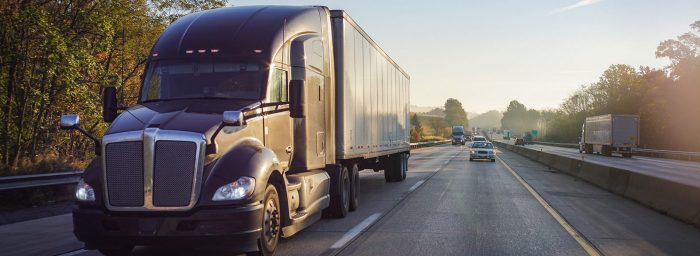The industry has recently seen increased emissions regulations, improvements in fuel economy, and upgrades to driver amenities – all great progress geared towards a better and more efficient transportation system. But all those changes have resulted in added weight. Even if your semi-trailer doesn’t max out at 80,000 pounds, the benefits of keeping your trailer light are immense.
Whether offsetting the weight added by other features or just a desire to carry more freight, freight efficiency is what really counts. Simply put, shaving off weight will increase profits.
There’s plenty for owner/operators and OEMs to consider when it comes to lightweighting solutions for their fleets. What are the best options? What uncertainty is associated with new technologies? Where are the ROIs most quickly realized?
The most honest, but least helpful, answer is: it depends.
A better approach for decision makers is to think through the following lightweighting factors and ask themselves how these benefits and challenges play into their businesses.
Lightweighting factors
Fuel savings
All other variables aside, an industry average puts 1,000 pounds of weight reduction at about 0.5% to 0.6% in fuel savings. Multiplied across the number of miles traveled by a fleet, these savings quickly add up.
Freight efficiency
The maximum legal weight for a semi-trailer is a well-known constraint tied to the vehicle class. Every pound shaved off the semi-trailer is another pound of cargo that can be carried, increasing freight efficiency.
Driver retention
Hiring and retaining drivers is critical in a market with astronomical consumer demand and projections pointing to further growth. Adding amenities to trucks and trailers improves the driver’s quality of life, contributing to employee retention. Lightweighting the trailer to offset added weight from amenities helps to maintain the total cost of ownership.
Fuel efficiency technology
Add-ons, like aerodynamic devices and idle-reduction solutions, trade improvements in fuel efficiency for added total mass. Lightweighting the semi-trailer helps to offset these products. A trend that’s emerged over the past decade of R&D is that almost all weight gain in the tractor is offset by weight reduction in the trailer. The U.S. Department of Energy’s SuperTruck program is a great example of how teams of engineers at the major OEMs have independently converged on this strategy.
Regulatory compliance
As concerns over climate change take a more dominant role on the international stage, new domestic regulations on vehicle weight, efficiency, and emissions are all but certain. Lightweighting semi-trailers today will help future proof against these regulatory conditions of tomorrow.
Sustainability
When paired with improved logistics, lightweighting semi-trailers can bring major sustainability gains by reducing the total number of vehicles needed to carry the same amount of cargo. Given the anticipated growth in market demand, implementation of lightweighting technology today is a proactive approach to sustain operations into the future.
Costs
Most market technologies for lightweighting bring added upfront costs, which reduce the net payback and ROI. Identifying cost-neutral solutions is essential to enable adoption by smaller fleet operators who have less borrowing power or less on-hand assets to invest in their business’ growth.
Lifecycle considerations
Most trailers spend a decade or so on the road before being sold, retired, or converted for use as storage containers. Looking ahead to view lightweighting from the perspective of end-of-life and lifecycle considerations begs the question of whether there will be reduced resale/salvage value, or a shortened operational lifetime due to corrosion and rot.
Maintenance costs
Lightweight aerospace composites are constantly being explored for adaptation into commercial transportation markets. A variety of lightweight trailers have already been demonstrated, but none have proven commercial viability. Major issues arise around the hurdles of durability and repairability. If the repair technician isn’t an expert in composite layup repair or has access to prepreg resin technology, the trailer spends more time in the shop than on the road.
Risk tolerance
Not every owner/operator is positioned to gamble on the latest and greatest lightweighting solution. Understanding new technology to appropriately gauge the added revenues or potential costs requires time to study information. However, businesses adopting new technology successfully increase their position to capture more of the market and increase their revenues.
A new solution for lightweighting semi-trailers
With these considerations in mind, it becomes easier for the owner/operator, or OEM to decide whether to invest in a lighter fleet. However, it doesn’t answer the simple question of: how do we reduce the weight?
Some research on the current options gives a less-than-exciting answer: most of the approaches to substantial lightweighting are still being explored at the academic level and involve advanced alloys or next-generation composite fiber technology. Surely great work will come from these efforts, but that doesn’t help today.
At Armory Technologies, we’ve brought to market a class of advanced materials that can be used to build new lightweight trailers today, or to retrofit trailers already on the road. Our mechanical metamaterial sandwich panels identify an opportunity for weight reduction in the semi-trailer’s sidewalls which are typically fabricated from a high-density polyethylene plastic foam core and thin sheet metal skins. 70% of new trailer builds use this 25+ year-old technology, making it a ripe opportunity for an upgrade.
Mechanical metamaterials are already established in markets outside the transportation sector. As new use cases are identified, their eventual integration into commercial transportation is inevitable. Key to the success of this technology is the ability to do more with less material. Ultimately, by using a metamaterial geometry with high shear strength and low mass density, existing plastic sidewall panel cores can easily be replaced with a lighter solution.
Multiplying the weight reduction benefits of the sidewalls over the ~1,000 sq-ft of a 53-ft trailer means the ROIs begin to accrue immediately through increased payload capacity, decreased operating costs, and greater total freight efficiency.





